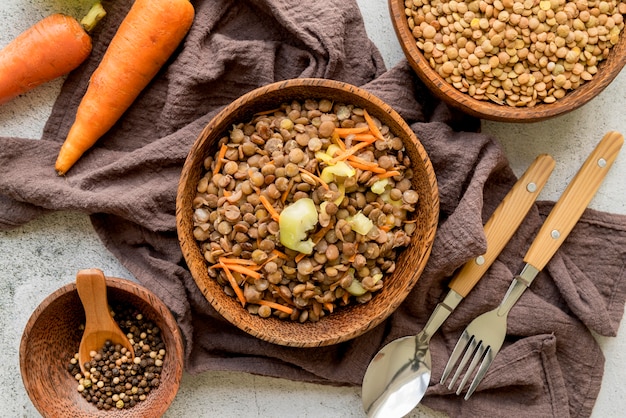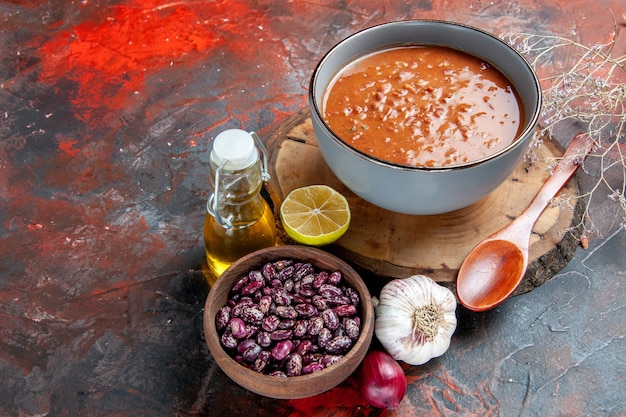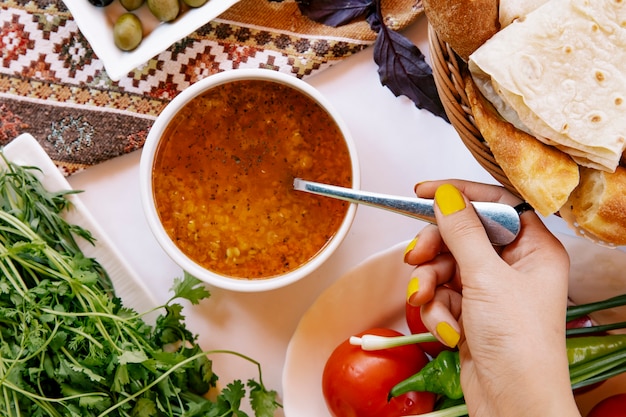Lentils, my friends, are a true kitchen hero. They're packed with protein, fiber, and essential nutrients, and they’re surprisingly affordable – a win-win in my book! From hearty lentil soups on chilly evenings to vibrant salads for light lunches, the possibilities are endless. This guide is your one-stop shop for all things lentil, covering everything from different types and cooking techniques to some of my favourite recipes and answers to your burning questions. So, settle in, grab a cuppa, and let’s dive into the world of lentils!
(Part 1) Understanding Lentils: The Basics

Lentils belong to the legume family, alongside beans and peas. They're a fantastic source of plant-based protein and fiber, making them a popular choice for vegetarians and those looking to add more plant-based foods to their diet. They come in a variety of colors and sizes, each with its own unique flavor and texture.
types of lentils: A Quick Guide
You'll find a rainbow of lentil varieties at your local supermarket, each with its own personality. Here's a quick breakdown of the most common types:
- brown lentils: These are the workhorses of the lentil world, known for their firm texture that holds up well in soups, stews, and salads. Their mild flavor blends seamlessly into any dish.
- green lentils: These little gems have a slightly earthy flavor and a firmer texture than their brown counterparts. They’re perfect for salads, dips, and side dishes where you want them to maintain their shape.
- red lentils: These split lentils are stars in Indian cuisine, known for their quick cooking time and soft, almost creamy texture. They break down easily, making them ideal for soups and curries.
- black lentils: These tiny lentils have a slightly sweet flavor and cook quickly. They are frequently used in Indian and Middle Eastern cuisine, adding a touch of elegance to dishes.
- french lentils: These small, round lentils have a dark brown color and a firm texture, holding their shape beautifully. They’re perfect for salads and side dishes where you want a bit of bite.
Choosing the Right Lentils for Your Recipe
Picking the right lentil for your recipe is key to achieving the perfect dish. Consider the texture you’re aiming for and the cooking time. For example, if you're making a hearty soup, red lentils are the way to go because they cook quickly and break down beautifully, creating a velvety texture. If you're creating a vibrant salad, green or French lentils are the stars, holding their shape well and adding a pleasing contrast to the other ingredients.
(Part 2) Mastering the Art of Cooking Lentils

Cooking lentils is surprisingly straightforward. It’s all about finding the perfect water-to-lentil ratio and simmering them until they're tender but not mushy. While there are various methods, my go-to technique is using a pot on the stovetop. It’s simple, reliable, and perfect for those nights when you want a comforting, home-cooked meal.
The Simple Stovetop Method
1. Rinse the lentils: Give your lentils a quick rinse under cold water to remove any debris. This ensures a cleaner flavor and texture.2. Combine lentils and water: In a large pot, add the rinsed lentils and water. The magic ratio is 3 cups of water for every 1 cup of lentils. 3. Bring to a boil, then simmer: Bring the water to a rolling boil, then reduce the heat to a gentle simmer, cover the pot, and let the lentils cook for 20-30 minutes, or until they're tender. 4. Check for doneness: As the lentils cook, check the water level. If it evaporates before the lentils are cooked through, add more water to ensure they don’t burn. 5. Drain excess water: Once the lentils are cooked, drain off any excess water. You'll have a pot of perfectly cooked lentils ready to be transformed into a delicious meal.
Tips for Perfect Lentils Every Time
Here are a few tricks that will help you cook lentils like a pro:
- Don’t overcook: Overcooked lentils turn mushy and lose their appealing texture. Keep a close eye on them towards the end of cooking time and taste test to ensure they're cooked through but still maintain their shape.
- Add a pinch of salt: A sprinkle of salt in the cooking water helps the lentils cook evenly and adds a subtle depth of flavor.
- Use a pressure cooker: If you’re short on time, a pressure cooker is your new best friend. It dramatically cuts down on cooking time. Follow the manufacturer’s instructions for perfect results.
- Don't drain too much water: Lentils absorb water as they cook, so don't drain all the excess water. Save some of the flavorful broth to use in your recipes – it’s a delicious base for soups and stews.
(Part 3) Lentil Soup: A Classic comfort food

Lentil soup is my go-to comfort food. It’s hearty, flavorful, and incredibly easy to make. It's also a fantastic way to use up leftover vegetables from your fridge. Here’s one of my tried-and-true recipes that I've been perfecting for years.
The Ultimate Lentil Soup
Ingredients:
- 1 tablespoon olive oil
- 1 onion, chopped
- 2 carrots, chopped
- 2 celery stalks, chopped
- 2 cloves garlic, minced
- 1 teaspoon ground cumin
- 1 teaspoon curry powder
- 1/2 teaspoon smoked paprika
- 1/2 teaspoon salt
- 1/4 teaspoon black pepper
- 1 cup brown lentils, rinsed
- 4 cups vegetable broth
- 1 (14.5 ounce) can diced tomatoes, undrained
- 1/2 cup chopped fresh parsley
- Warm up the olive oil in a large pot over medium heat.
- Add the onion, carrots, and celery and cook until they soften, about 5 minutes.
- Stir in the garlic, cumin, curry powder, paprika, salt, and pepper and cook for 1 minute more, allowing the spices to release their aromas.
- Add the lentils, broth, and diced tomatoes. Bring the mixture to a boil, then reduce heat to a simmer, cover the pot, and let it cook for 30 minutes, or until the lentils are tender.
- Right before serving, stir in the parsley for a burst of freshness.
Feel free to adjust the spices to suit your taste. For a touch of heat, add a pinch of cayenne pepper. And don't forget to finish it off with a dollop of Greek yogurt or a sprinkle of fresh herbs for that extra touch of flavour.
(Part 4) Beyond Soup: Exploring Lentil Dishes
Lentils aren't just for soups, you know! They can be stars in a variety of dishes, from hearty stews and salads to vegetarian burgers and pasta sauces. I’m always on the hunt for new and creative ways to use lentils. Here are a few ideas to inspire you:
lentil salads: A Light and Refreshing Option
Lentil salads are a fantastic way to enjoy lentils on a warm day. They’re bursting with flavor and texture, and you can customize them with your favorite vegetables and herbs. Here’s a simple recipe to get you started:
Mediterranean Lentil Salad
Ingredients:
- 1 cup green lentils, cooked
- 1 cucumber, diced
- 1/2 cup cherry tomatoes, halved
- 1/4 cup red onion, chopped
- 1/4 cup Kalamata olives, pitted and sliced
- 1/4 cup chopped fresh parsley
- 1/4 cup crumbled feta cheese
- 2 tablespoons olive oil
- 1 tablespoon lemon juice
- Salt and pepper to taste
- Combine the lentils, cucumber, tomatoes, red onion, olives, and parsley in a large bowl.
- In a small bowl, whisk together the olive oil, lemon juice, salt, and pepper.
- Pour the dressing over the salad and toss to combine.
- Top with the feta cheese before serving.
This salad is a perfect side dish or a light lunch. I love serving it with crusty bread and a glass of chilled white wine.
Lentil Burgers: A Vegetarian Feast
Lentil burgers are a delicious and healthy alternative to traditional beef burgers. They’re packed with protein and fiber, and they’re incredibly satisfying. Here's a recipe that's a real crowd-pleaser:
Black Bean and Lentil Burgers
Ingredients:
- 1 cup black beans, cooked
- 1 cup brown lentils, cooked
- 1/2 cup rolled oats
- 1/2 cup chopped onion
- 1/4 cup chopped fresh cilantro
- 1 clove garlic, minced
- 1 teaspoon chili powder
- 1/2 teaspoon cumin
- 1/4 teaspoon salt
- 1/4 teaspoon black pepper
- 1 egg, lightly beaten
- In a large bowl, combine the black beans, lentils, oats, onion, cilantro, garlic, chili powder, cumin, salt, and pepper.
- Stir in the egg and mix well to combine.
- Shape the mixture into 4 patties.
- Heat a large skillet over medium heat and cook the patties for 5 minutes per side, or until cooked through.
- Serve the burgers on buns with your favourite toppings, like lettuce, tomato, and avocado.
These lentil burgers are incredibly versatile. I like to serve them with a side of sweet potato fries or a green salad. They're perfect for a casual weeknight dinner or a laid-back weekend gathering.
(Part 5) Lentils in Indian Cuisine: A World of Flavours
Lentils are a star ingredient in Indian cuisine. They lend themselves beautifully to the complex and flavorful dishes that are so characteristic of this culinary tradition. Indian lentil dishes are often vegetarian, making them a great option for those following a plant-based diet.
Dal Makhani: The Rich and Creamy Delight
Dal Makhani is a classic Indian lentil dish known for its rich, creamy texture and complex flavor. It’s a real labor of love, but the result is absolutely worth it. Here’s a recipe to try at home:
Dal Makhani
Ingredients:
- 1 cup black lentils, rinsed
- 1 cup red lentils, rinsed
- 1 tablespoon olive oil
- 1 onion, chopped
- 2 cloves garlic, minced
- 1 inch ginger, grated
- 1 teaspoon ground cumin
- 1/2 teaspoon turmeric powder
- 1/2 teaspoon garam masala
- 1/2 teaspoon red chili powder (optional)
- 1 (14.5 ounce) can diced tomatoes, undrained
- 1 cup water
- 1/2 cup heavy cream
- Salt and pepper to taste
- Fresh cilantro, chopped (for garnish)
- Combine the black lentils and red lentils in a large pot. Add enough water to cover the lentils by about 2 inches. Bring to a boil, then reduce heat to a simmer, cover, and cook for about 30-40 minutes, or until the lentils are tender.
- While the lentils are simmering, heat the olive oil in a separate pan over medium heat. Add the onion and cook until softened, about 5 minutes. Add the garlic and ginger and cook for 1 minute more.
- Add the cumin, turmeric, garam masala, and chili powder (if using) to the pan and cook for 1 minute, stirring constantly.
- Add the diced tomatoes and water to the pan and bring to a boil. Reduce heat to a simmer and cook for 10 minutes.
- Add the cooked lentils to the tomato mixture and stir to combine. Simmer for 10 minutes, or until the flavors have melded.
- Stir in the heavy cream and season with salt and pepper to taste.
- Serve the dal makhani hot, garnished with fresh cilantro.
Dal Makhani is often served with rice or naan bread. I like to pair it with a simple side of raita, a yogurt-based sauce that helps to cool down the heat of the spices. This dish is a true testament to the depth and richness of Indian cuisine.
(Part 6) Lentils in Mediterranean Cuisine: A Taste of the Sun
Lentils are a staple in Mediterranean cuisine, adding a hearty and satisfying protein boost to dishes. They complement the bright and fresh flavours of Mediterranean cuisine, creating a delicious and balanced culinary experience.
Lentil and Chickpea Stew: A Simple and Savoury Delight
This lentil and chickpea stew is a simple yet incredibly satisfying dish. It’s packed with flavour and texture, and it’s a great way to warm up on a chilly evening. Here’s a recipe you can whip up in no time:
Lentil and Chickpea Stew
Ingredients:
- 1 tablespoon olive oil
- 1 onion, chopped
- 2 carrots, chopped
- 2 celery stalks, chopped
- 2 cloves garlic, minced
- 1 teaspoon ground cumin
- 1/2 teaspoon smoked paprika
- 1/4 teaspoon salt
- 1/4 teaspoon black pepper
- 1 cup brown lentils, rinsed
- 1 (15 ounce) can chickpeas, drained and rinsed
- 4 cups vegetable broth
- 1 (14.5 ounce) can diced tomatoes, undrained
- 1/2 cup chopped fresh parsley
- Lemon wedges (for serving)
- Heat the olive oil in a large pot over medium heat. Add the onion, carrots, and celery and cook until softened, about 5 minutes.
- Add the garlic, cumin, paprika, salt, and pepper and cook for 1 minute more.
- Stir in the lentils, chickpeas, broth, and diced tomatoes.
- Bring to a boil, then reduce heat to a simmer, cover, and cook for 30 minutes, or until the lentils and chickpeas are tender.
- Stir in the parsley before serving. Serve the stew hot with lemon wedges.
You can add a squeeze of lemon juice to the stew before serving, or even a dollop of Greek yogurt or a sprinkle of crumbled feta cheese for an extra touch of flavour. This stew is a great way to use up leftover vegetables, and it’s a real crowd-pleaser.
(Part 7) Lentils and Sustainability: A Nutritious and Eco-Friendly Choice
Lentils are a champion for sustainability. They're a relatively low-impact crop, requiring less water and land than other protein sources. They also have a lower carbon footprint compared to meat and dairy products.
Environmental Benefits of Lentils
Here are some of the key reasons why choosing lentils is a good decision for our planet:
- Water conservation: Lentils require significantly less water to grow than other protein sources, such as beef, chicken, and rice. This is especially crucial in regions facing water scarcity.
- Land use efficiency: Lentils are adaptable, growing in a variety of climates and soil types. They also produce a high yield per acre, meaning they need less land to produce a given amount of protein.
- Carbon footprint: The production of lentils has a lower carbon footprint than the production of meat and dairy products. This is because they require less energy and resources to grow.
- Nitrogen fixation: As a legume, lentils have the ability to fix nitrogen from the air, enriching the soil and reducing the need for synthetic fertilizers. This helps to improve soil health and reduces the environmental impact of fertilizer production.
Choosing lentils over other protein sources can make a real difference in reducing your environmental impact. By opting for more sustainable options, we can work towards a healthier and more sustainable food system for the future.
(Part 8) FAQs: Your Lentil Questions Answered
Lentils often spark curiosity, and I’m always happy to share my knowledge. Here are some of the most common questions, along with my answers:
1. Can you eat lentils raw?
It's best to avoid eating lentils raw. They contain lectins, which can cause digestive issues. Cooking lentils breaks down these lectins, making them easier to digest and more enjoyable to eat.
2. How long do lentils last in the fridge?
Cooked lentils will last in the refrigerator for up to 5 days. Store them in an airtight container to keep them fresh and flavorful. To reheat, add a splash of water or broth and microwave or heat them on the stovetop.
3. Can you freeze lentils?
Yes, you can freeze cooked lentils. To freeze them, spread them out on a baking sheet and freeze for about 30 minutes, or until they're frozen solid. Then transfer them to a freezer-safe bag and store them in the freezer for up to 3 months. To reheat frozen lentils, thaw them in the refrigerator overnight or microwave them until heated through. This is a great way to have a quick and easy meal on hand.
4. Are lentils good for weight loss?
Lentils are a great food for weight loss because they're low in calories and high in fiber and protein. Fiber helps you feel full and satisfied, and protein helps to keep you feeling full for longer. This can help you eat less overall and manage your weight.
5. Are lentils gluten-free?
Yes, lentils are naturally gluten-free. They’re a fantastic option for people with celiac disease or gluten sensitivity. Just be sure to check the ingredients of any processed lentil products to ensure they haven’t been cross-contaminated with gluten.
(Part 9) The Lentil Journey: An Ongoing Adventure
The world of lentils is always full of surprises, and I’m constantly experimenting with new recipes and flavour combinations. I encourage you to do the same. It’s a delicious journey of culinary discovery.
So, go forth and conquer the world of lentils! Get creative, have fun, and enjoy the incredible taste and versatility of these little legumes. You’ll be amazed at just how many delicious dishes you can create with them.
Everyone is watching

Corn on the Cob: The Ultimate Guide to Perfectly Cooked Ears
Healthy MealsAh, corn on the cob. Just the name evokes images of sunny days, barbecues, and that sweet, juicy flavour that ...

Perfect Pork Roast Oven Cooking Time: A Guide to Delicious Results
Healthy MealsThere's something truly satisfying about a perfectly roasted pork. The aroma alone is enough to make your mout...

Ham Cooking Time: How Long to Bake, Smoke, or Boil a Delicious Ham
Healthy MealsAh, ham. It's a classic, isn't it? A real crowd-pleaser, especially around holidays. And when done right, it'...

Scallops: The Ultimate Guide to Perfect Cooking
Healthy MealsAh, scallops. Those delicate, sweet, and utterly delicious morsels of the sea. They hold a special place in my...

Spaghetti Squash: The Ultimate Guide to Cooking and Serving
Healthy MealsRemember that time you saw spaghetti squash at the supermarket, looking all bumpy and strange, and thought, "W...
